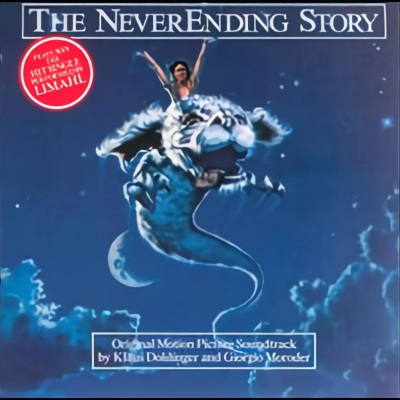
The Never Ending Story (Original Motion Picture Soundtrack)
故事讲述小男孩Bastian Bux迷上了一本名叫《永不结束的故事》的书,故事将Bastian Bux深深吸引到书本里,甚至让他幻想自己就是其中最重要的角色。而书中描述的幻想国逐渐被“空无”吞噬,女王因为重病无法抵抗“空无”,于是幻想国派出勇者Atreyu寻找拯救女王的药,Bastian Bux就在Atreyu的追寻中体验幻想国的每个地方、认识每个人物,随着Atreyu的欢喜与挫折起伏…… 幻想国之所以被“空无”吞噬,是因为她是由人类的幻想所创造出来的国度,当人类不再幻想,并忘记那些幻想时,幻想国当然就什么也不剩了。Bastian Bux最后发现幻想国中的人并没有办法拯救他们自己,只有人类才能拯救幻想国,他必须靠着丰沛的想像力,重现幻想国的生机…… by Evan Cater The soundtrack for The Never Ending Story , Wolfgang Peterson 's film adaptation of the German children's fantasy Die Unendliche Gesichte , is divided into two parts. The first consists of keyboard and electric guitar compositions by synth wizard Giorgio Moroder , who contributed much of the electronic music used by Holywood in the '80s. The second half is a more traditional orchestral score by German composer Klaus Doldinger. Although Moroder's side of the record includes his charmingly fanciful theme song "The Never Ending Story" (performed by pop star Limahl ), Doldinger's side is ultimately the more winning. With the exception of "Ivory Tower," an exuberantly muscular piece that was used as the B-side of the 7" single for Limahl song, Moroder seems to have been stuck with the task of scoring the darker, more melancholy scenes in the movie -- as indicated by track titles like "Swamps of Sadness" and "Ruined Landscape." In contrast, Doldinger gets to score pieces like "Bastian's Happy Flight," "Fantasia," and "Atreyu's Quest." Consequently the first side of the record is characterized by murky solemnity while the second is largely soaring and energetic. This dichotomy is appropriate for a film that alternates between exhilaration of a young boy's adventure and the despair of a kingdom facing total annihilation. But the sequencing makes for a difficult listen. The soundtrack might be more enjoyable if the film's musical highs and lows had been better integrated.
